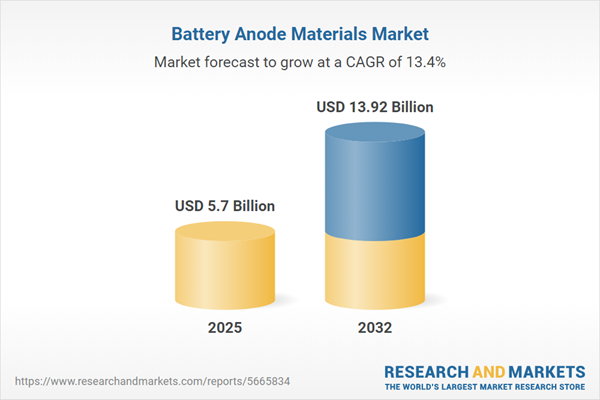Speak directly to the analyst to clarify any post sales queries you may have.
The battery anode materials market is evolving rapidly, marked by technological innovation, shifting regional priorities, and emerging supply chain challenges. Senior decision-makers need actionable insights to navigate these changes and capitalize on new opportunities in advanced energy storage solutions.
Market Snapshot: Battery Anode Materials Market
The battery anode materials market grew from USD 5.09 billion in 2024 to USD 5.70 billion in 2025, and is projected to sustain strong momentum at a CAGR of 13.40%, reaching USD 13.92 billion by 2032. This continued expansion is driven by rising adoption in electric mobility, stationary energy storage, and consumer electronics, highlighting the sector's resilience and adaptive supply chains.
Scope & Segmentation of the Battery Anode Materials Market
This report delivers detailed segmentation and analysis to support strategic choices in a rapidly evolving landscape:
- Material Types: Graphite anodes (including natural graphite and synthetic graphite), lithium titanate oxide, and silicon-based materials such as silicon nanoparticles and silicon-carbon composites.
- Battery Types: Lead-acid, lithium-ion, lithium-sulfur, and nickel-metal hydride chemistries, covering applications from established sectors to emerging designs.
- Form Factors: Cylindrical anodes, pouch cell anodes, and prismatic anodes, supporting varied production and engineering requirements.
- Manufacturing Methods: Coated and treated anodes, nano-engineered materials, and spherical graphite processes for enhanced performance and scalability.
- End-Use Sectors: Aerospace and defense, automotive (including commercial and passenger vehicles), consumer electronics (laptops, smartphones, wearables), and industrial equipment (heavy machinery, power tools).
- Regional Coverage: Americas (United States, Canada, Mexico, Brazil, Argentina, Chile, Colombia, Peru), Europe, Middle East & Africa (United Kingdom, Germany, France, Russia, Italy, Spain, Netherlands, Sweden, Poland, Switzerland, United Arab Emirates, Saudi Arabia, Qatar, Turkey, Israel, South Africa, Nigeria, Egypt, Kenya), and Asia-Pacific (China, India, Japan, Australia, South Korea, Indonesia, Thailand, Malaysia, Singapore, Taiwan).
- Companies Profiled: Amprius Technologies, Anovion LLC, BASF SE, BTR New Material Group, Daejoo Electronic Materials, E-magy, Enevate Corporation, Epsilon Advanced Materials, Gotion High-tech, Himadri Speciality Chemicals, Hunan Kingi Technology, JFE Chemical, Kanthal AB, Kuraray, Kureha Corporation, Mitsubishi Chemical, NEI Corporation, NEO Battery Materials, Nexeon, Ningbo Shanshan, Nippon Carbon, POSCO Group, Resonac Holdings, SGL Carbon, Shin-Etsu Chemical, Sila Nanotechnologies, Sumitomo Chemical, Talga Group, Targray Technology, Tokai Carbon by Cabot Corporation, Vianode AS.
Key Takeaways for Senior Decision-Makers
- Advanced anode technologies, including silicon-infused composites and nano-engineered coatings, are demonstrating clear differentiation in energy density and lifecycle performance.
- Material sourcing strategies are under scrutiny, with purity, raw material continuity, and regional policy incentives influencing long-term competitiveness and sustainability.
- The rise of next-generation applications in electric vehicles, stationary storage, and miniaturized electronics is pushing manufacturers to tailor solutions by battery type and form factor.
- Strategic collaborations among raw material suppliers, technology providers, and OEMs are critical to drive innovation speed and supply security.
- Sustainability and lifecycle analysis frameworks are becoming central to procurement and product design, reflecting tightening regulations and evolving customer expectations.
Tariff Impact: Strategic Adjustments in Response to U.S. Trade Policy
With the 2025 tariff framework in the United States, manufacturers have expedited investments in North American processing and strengthened partnerships in Canada and Mexico to reduce tariff exposure. These adjustments have encouraged supply chain localization and cross-border collaboration, impacting sourcing, cost dynamics, and operational planning across the market. Eligibility for tariff exemptions in R&D has offered some relief for innovation-focused initiatives, though long-term production strategies continue to prioritize diversification and regional integration.
Methodology & Data Sources
This research applies a rigorous blend of secondary research, technical analysis, and expert interviews to ensure robust, validated insights. Primary data is drawn from laboratory testing and sector specialists, while secondary validation includes industry reports, patents, and regulatory documentation. Peer review by industry veterans underpins the integrity of conclusions.
Why This Report Matters
- Provides a comprehensive framework for evaluating technology, regulatory impacts, and supply chain shifts in the battery anode materials space.
- Supports strategy development for sourcing, partnership building, and operational risk management amid market transition.
- Enables informed decision-making with actionable segmentation and detailed competitive profiling tailored to the evolving requirements of energy storage innovation.
Conclusion
The global battery anode materials market is characterized by rapid technological change and evolving regional dynamics. This report equips senior leaders with the context and guidance required to adapt strategies and capture growth in the competitive energy storage landscape.
Additional Product Information:
- Purchase of this report includes 1 year online access with quarterly updates.
- This report can be updated on request. Please contact our Customer Experience team using the Ask a Question widget on our website.
Table of Contents
3. Executive Summary
4. Market Overview
7. Cumulative Impact of Artificial Intelligence 2025
Companies Mentioned
The companies profiled in this Battery Anode Materials market report include:- Amprius Technologies
- Anovion LLC
- BASF SE
- BTR New Material Group Co., Ltd.
- Daejoo Electronic Materials Co., Ltd.
- E-magy
- Enevate Corporation
- Epsilon Advanced Materials Pvt. Ltd.
- Gotion High-tech Co., Ltd.
- Himadri Speciality Chemicals Ltd.
- Hunan Kingi Technology Co., Ltd.
- JFE Chemical Corporation
- Kanthal AB
- Kuraray Co., Ltd.
- Kureha Corporation
- Mitsubishi Chemical Corporation
- NEI Corporation
- NEO Battery Materials Ltd.
- Nexeon Ltd.
- Ningbo Shanshan Co., Ltd.
- Nippon Carbon Co., Ltd.
- POSCO Group
- Resonac Holdings Corporation
- SGL Carbon SE
- Shin-Etsu Chemical Co., Ltd.
- Sila Nanotechnologies Inc.
- Sumitomo Chemical Co., Ltd.
- Talga Group
- Targray Technology International Inc.
- Tokai Carbon Co., Ltd. by Cabot Corporation
- Vianode AS
Table Information
| Report Attribute | Details |
|---|---|
| No. of Pages | 180 |
| Published | November 2025 |
| Forecast Period | 2025 - 2032 |
| Estimated Market Value ( USD | $ 5.7 Billion |
| Forecasted Market Value ( USD | $ 13.92 Billion |
| Compound Annual Growth Rate | 13.4% |
| Regions Covered | Global |
| No. of Companies Mentioned | 32 |








